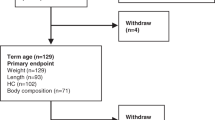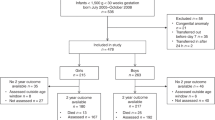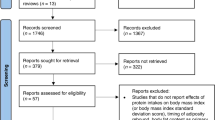Abstract
Objective:
To explore the effect of birth weight on urea kinetics in young healthy children.
Design:
Observational study.
Setting:
Tertiary center for treatment of malnutrition.
Subjects:
A total of 17 male children, 6–24 months old, who had recovered from malnutrition.
Interventions:
Urea kinetics were measured using stable isotope methodology with [15N15N]-urea over 36 h.
Results:
Birth weight was negatively related to urea hydrolysis after controlling for the intake of protein (adjusted R2=0.91, P=0.001) and separately for energy intake (adjusted R2=0.95, P=0.001), age (adjusted R2=0.90, P=0.001) and rate of weight gain (adjusted R2=0.91, P=0.001). There was a tendency for higher urea production in the children with lower birth weight after controlling for nitrogen intake (adjusted R2=0.93, P=0.099), and separately for age (adjusted R2=0.94, P=0.06) and rate of weight gain (adjusted (R2=0.92, P=0.096). Urea excretion was not significantly related to birth weight.
Conclusions:
The salvaging of urea nitrogen following urea hydrolysis contributed significantly more to the nitrogen economy in children with lower birth weight compared to those with higher birth weight. This may be as a result of reductive adaptation in the children with lower birth weight as a consequence of inappropriate prenatal nutrition and growth.
This is a preview of subscription content, access via your institution
Access options
Subscribe to this journal
Receive 12 print issues and online access
$259.00 per year
only $21.58 per issue
Buy this article
- Purchase on Springer Link
- Instant access to full article PDF
Prices may be subject to local taxes which are calculated during checkout

Similar content being viewed by others
References
Badaloo A, Boyne M, Reid M, Persaud C, Forrester T, Millward DJ et al. (1999). Dietary protein, growth and urea kinetics in severely malnourished children and during recovery. J Nutr 129, 969–979.
Danielsen M, Jackson AA (1992). Limits of adaptation to a diet low in protein in normal man: urea kinetics. Clin Sci (Lond) 83, 103–108.
Desai M, Byrne CD, Meeran K, Martenz ND, Bloom SR, Hales CN (1997a). Regulation of hepatic enzymes and insulin levels in offspring of rat dams fed a reduced-protein diet. Am J Physiol 273, G899–G904.
Desai M, Byrne CD, Zhang J, Petry CJ, Lucas A, Hales CN (1997b). Programming of hepatic insulin-sensitive enzymes in offspring of rat dams fed a protein-restricted diet. Am J Physiol 272, G1083–G1090.
Desai M, Crowther NJ, Ozanne SE, Lucas A, Hales CN (1995). Adult glucose and lipid metabolism may be programmed during fetal life. Biochem Soc Trans 23, 331–335.
Forrester T, Badaloo AV, Persaud C, Jackson AA (1994). Urea production and salvage during pregnancy in normal Jamaican women. Am J Clin Nutr 60, 341–346.
Gale CR, Martyn CN, Kellingray S, Eastell R, Cooper C (2001). Intrauterine programming of adult body composition. J Clin Endocrinol Metab 86, 267–272.
Gaskin P, Walker SP, Forrester TE, Grantham-McGregor SM (1997). The validity of recalled birthweight in developing countries. Am J Public Health 87, 114.
Giordano C, De Pascale C, Balestrieri C, Cittadini D, Crescenzi A (1968). Incorporation of urea 15N in amino acids of patients with chronic renal failure on low nitrogen diet. Am J Clin Nutr 21, 394–404.
Hamill PV, Drizd TA, Johnson CL, Reed RB, Roche AF, Moore WM (1979). Physical growth: National Center for Health Statistics percentiles. Am J Clin Nutr 32, 607–629.
Henry CJ, Payne PR, Ghusain-Choueiri A (1997). Relationship between tissue mobilization and storage in the rat. Br J Nutr 78, 131–141.
Jackson AA (1999). Maternal and fetal demands for nutrients: significance of protein metabolism. In: PMS O’Brien, T Wheeler, DJP Barker (eds). ‘Fetal Programming: Influences on Development and Disease in Later Life’. RCOG Press: London. pp 246–270.
Jackson AA (2000a). Nitrogen Trafficking and recycling through the human bowel. In: P Furst, V Young (eds). Nestle Nutrition Workshop Series: Proteins, Peptides and amino acids in Enteral Nutrition. Karger AG Basel: Vevey. pp 89–108.
Jackson AA (2000b). Nutrients, growth, and the development of programmed metabolic function. Adv Exp Med Biol 478, 41–55.
Jackson AA, Doherty J, de Benoist MH, Hibbert J, Persaud C (1990). The effect of the level of dietary protein, carbohydrate and fat on urea kinetics in young children during rapid catch-up weight gain. Br J Nutr 64, 371–385.
Jackson AA, Picou D, Landman J (1984). The non-invasive measurement of urea kinetics in normal man by a constant infusion of 15N15N-urea. Hum Nutr Clin Nutr 38, 339–354.
Millward DJ, Forrester T, Ah-Sing E, Yeboah N, Gibson N, Badaloo A et al. (2000). The transfer of 15N from urea to lysine in the human infant. Br J Nutr 83, 505–512.
Ozanne SE, Hales CN (1999). The long-term consequences of intra-uterine protein malnutrition for glucose metabolism. Proc Nutr Soc 58, 615–619.
Payne PR, Dugdale AE (1977). A model for the prediction of energy balance and body weight. Ann Hum Biol 4, 525–535.
Ravelli AC, van Der Meulen JH, Osmond C, Barker DJ, Bleker OP (1999). Obesity at the age of 50 y in men and women exposed to famine prenatally. Am J Clin Nutr 70, 811–816.
Ravelli GP, Stein ZA, Susser MW (1976). Obesity in young men after famine exposure in utero and early infancy. N Engl J Med 295, 349–353.
Steinbrecher HA, Griffiths DM, Jackson AA (1996). Urea production in normal breast-fed infants measured with primed/intermittent oral doses of urea. Acta Paediatr 85, 656–662.
Strauss RS, Dietz WH (1998). Growth and development of term children born with low birth weight: effects of genetic and environmental factors. J Pediatr 133, 67–72.
Tanaka N, Kubo K, Shiraki K, Koishi H, Yoshimura H (1980). A pilot study on protein metabolism in the Papua New Guinea highlanders. J Nutr Sci Vitaminol (Tokyo) 26, 247–259.
Walser M, Bodenlos LJ (1959). Urea metabolism in man. J Clin Invest 38, 1617–1626.
Acknowledgements
This research was supported by a grant from the Nestlé Foundation.
Author information
Authors and Affiliations
Corresponding author
Additional information
Guarantors: A Badaloo and T Forrester.
Contributors: TEF had the idea for this investigation. AAJ, TEF, AVB and MB directed the study design. All authors were involved in conducting the studies, data analysis and writing the report.
Rights and permissions
About this article
Cite this article
Badaloo, A., Reid, M., Boyne, M. et al. Relationship between birth weight and urea kinetics in children. Eur J Clin Nutr 60, 197–202 (2006). https://doi.org/10.1038/sj.ejcn.1602288
Received:
Revised:
Accepted:
Published:
Issue Date:
DOI: https://doi.org/10.1038/sj.ejcn.1602288



